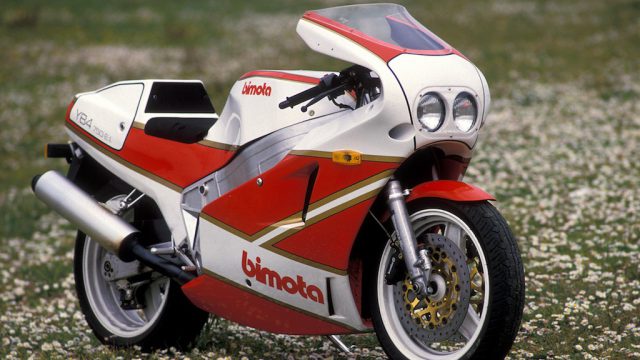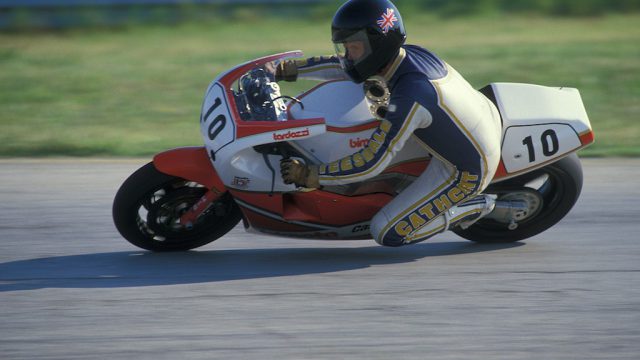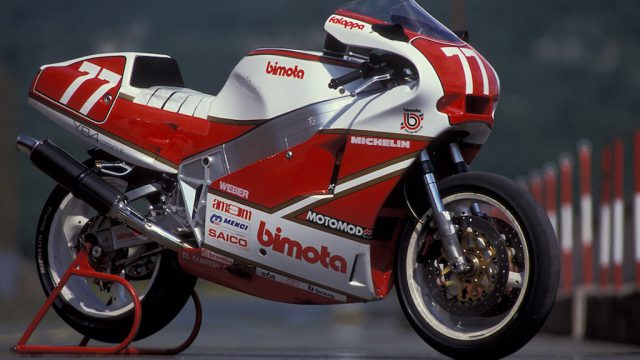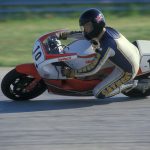The first four-cylinder sportbike to be equipped with electronic fuel-injection
Exactly 30 years ago on April 3rd, 1988, the first-ever race in the World Superbike Championship was staged at Donington Park in Britain. It was won by Davide Tardozzi on the works Bimota YB4EI-R, marking the first step in what promised to be a march to the inaugural World title by the small, specialist Italian manufacturer’s 750cc four-cylinder Yamaha-engined bike. But, after crashing in the second race held there that day, Tardozzi forfeited any points at all on combined results for his victory in the day’s first race – an anomaly in the rules that was immediately corrected, but not backdated, eventually depriving him and Bimota of the World Superbike title each undoubtedly deserved.

For after winning five races in the nine SBK rounds held that year – two more than any other rider – Tardozzi went into the final race of the 1988 series in New Zealand leading on points, only to crash out on the warm-up lap and fail to start the race, handing the slower but more consistent Fred Merkel the first-ever World Superbike crown on his RC30 Rumi Honda.

This wasn’t just a personal tragedy for Tardozzi and the tiny Bimota concern, but seemingly all the unfairer because it was the Yamaha-powered fuel-injected YB4EI which effectively pointed the way for future generations of sportbikes from much larger and richer manufacturers, especially in Japan, to excel in both the racetrack and the showroom. Launched in fuel-injected street guise at the 1987 Milan Show, the YB4EI was the work of the company's far-sighted progettista Federico Martini, and in carburetted guise in the hands of Virginio Ferrari had previously wrested the 1987 World TT F1 crown from Joey Dunlop and the Honda trophy cabinet. So Tardozzi’s World Superbike challenge was recognition of the specialist Italian manufacturer's successful efforts to push back the frontiers of two-wheeled technology, then deliver the results to their customers on the street in the form of a racer-with-lights. For the lucky owners of the 317 YB4EI customer bikes made by Bimota from 1987 to 1989 – 19 of them the YB4EI-R competition version – it set new standards in four-cylinder handling and poise.
This was in every way the first Superbike of the modern era, which was cruelly denied the World title that its technical excellence and competitive performance ultimately deserved
For the Bimota YB4EI was the first series production four-stroke motorcycle to employ a GP-style aluminium twin-spar frame, of the type so universal today on Japanese sportbikes of any capacity. It was Bimota which first brought such racetrack-derived chassis technology to the street – as well as introducing what was arguably an even greater landmark in engine management. For the YB4EI was the first four-cylinder sportbike (BMW’s K100 ‘flying brick’ which narrowly preceded it not being remotely sporty) to be equipped with electronic fuel-injection – and on a Japanese motor, at that, Yamaha's 20-valve FZ750 engine. It took even Honda more than half a decade to follow suit with the RC45, long after Bimota had refined its Weber/Marelli engine management system to uncover EFl's inbuilt benefits of better acceleration, reduced fuel consumption, a lighter and more responsive throttle action, and lower emissions – already by then an increasingly vital aspect of street R&D. The YB4EI-R which won the first ever SBK race at Donington two decades ago was in every way the prototype of today’s four-cylinder Superbikes.

For 1989, Tardozzi was replaced in the works Bimota SBK team by another legendary name from World Superbike's early years, Giancarlo Falappa, a reformed crossista whose spectacular way-out race-winning style brought him instant acclaim in only his second season of road racing and, in due course, a works Ducati contract. Riding Giancarlo's fuel-injected works YB4EI-R on the Rijeka GP circuit in what was then still Yugoslavia was an introduction to the modern world of Superbike racing, in spite of ‘only’ having three-quarters of the engine capacity and two-thirds of the horsepower of a current SBK four. For Bimota had by now much refined the then-innovative Weber/Marelli EFl, whose R&D hiccups had ultimately cost the Italian factory the debut World Superbike crown in 1988, with Tardozzi suffering engine management problems on his B-B-B-Bimota in several races, most notably in Japan and Australia. Now the pickup from the responsive but quite stiff throttle was predictable and precise rather than hit-‘n’-miss, albeit it still very fierce. The improved fuelling of the fuel-injected bike helped deliver 132 bhp to the rear wheel at 12,200 rpm from the highly modified yet obsolescent FZ750 engine that was replaced in Yamaha’s 1989 range by the short-stroke OW 01 – compared to 115 bhp in carburetted YB4 form two years earlier, fitted with tuning parts mostly restricted to the contents of the Yamaha race kit.
Complete bike scaled 158kg with oil and water, no fuel, to which 7kg of lead ballast had to be added to meet the 165kg four-cylinder minimum weight limit!
This was achieved by Bimota’s comprehensive re-engineering of the FZ motor’s internals with parts specially made by a legion of European suppliers, with a new lighter crankshaft, Pankl titanium conrods, 0.3mm oversize Mondial pistons to bring capacity up to a full 749cc and deliver 12:1 compression, 1mm larger valves each now fitted with dual springs, and a selection of trick camshafts to suit different circuits, all matched to the Yamaha racekit’s dry clutch and close-ratio gearbox, with the bottom three ratios specially reworked for Bimota by their Japanese engine partner. Added to this, Bimota led the way for other teams in developing a telemetry system to enhance setup on a motorcycle that was the first of the current breed of four-stroke Superbike racers – short, light (165kg once an amazing seven kilos of lead ballast had been added to meet the four-cylinder weight limit), and with an aggressive power delivery, coupled with an appetite for revs which dictated constant use of the close-ratio gearbox to keep it in the five-figure rpm scale. Indeed, the Bimota was a true four-stroke GP racer – a decade and a half before the invention of MotoGP…

And just as hard to ride, because from being a superfast pussy of a racebike in the carburetted TT F1 form with which Virginio Ferrari had won Bimota its second World title in 1987, the fuel-injected YB4EI-R was a different breed of cat, ferocious and snarling, that you needed to master. To obtain competitive horsepower from the Yamaha engine, Bimota had had to narrow the power band and go for revs – lots of them. The power delivery was fierce, with little happening until the LCD readout on the digital TDD dash that was so hard to read in bright Yugoslav sunshine, showed north of 8,000 rpm, and the Bimota started fuelling properly. From 9,500 rpm upwards there was truly explosive power on tap, sending the YB4EI-R rocketing forward, wriggling and weaving as great gobs of power were released to the rear Michelin tyre. But with that 12,200 rpm peak and a 13,000 rpm revlimiter, you didn’t have much of a powerband to play with – certainly not by the standards of today’s meaty ultrabikes.

The result was like riding a 500GP two-stroke of the era with the powervalve disconnected – you had to try very hard not to let the revs drop below that power threshold, else be prepared to suffer the sudden surge of torque and a horsepower hit that would quite easily unhook the rear Michelin – especially when getting on the gas again from a closed throttle, after trailbraking deep into a turn. Indeed, it was the Bimota’s vicious response and harsh pickup which caught Tardozzi out a handful of times in his World Superbike year, not only on that warmup lap in NZ with cold tyres in those pre-tyrewarmer days, but most likely when he crashed at Donington at the start of the season, trying on worn tyres to double-up on race wins with a last lap pass on Lucchinelli’s race-leading Ducati. Several times at Rijeka, especially out of slower turns, I found myself unhooking the rear with the Bimota’s abrupt pickup on part-throttle, which on period Michelin radial rubber so much less forgiving than today’s Pirelli SBK control tyres, gave constant cause for concern. I was thankful reformed crossista Giancarlo Falappa had fitted his trademark wide, flat handlebars which gave lots of leverage for correcting a slide! His unique riding style certainly suited the Bimota’s explosive power delivery.

Fortunately, the Bimota’s Martini-designed, beautifully-fabricated twin-spar chassis was well-behaved and controllable, helping harness that aggressive power delivery and allowing serious corner speed through Rijeka's fast turns. Made in Anticorda 100 aircraft alloy, it had the slant-block Yamaha engine tilted back in the frame so that its cylinders lay at an angle of 36º from vertical, rather than the original FZ750's 45º. This was aimed at obtaining a shorter wheelbase, achieved by recasting a new magnesium sump to allow the Bimota-developed exhaust to sit snugly under the engine, and later copied by Yamaha itself on the OW 01.

Fitted with then-rare Öhlins suspension, the result was also stable under heavy braking, where the effective 320mm Brembo front brakes with their four-piston calipers really excelled in stopping a bike that was noticeably small and svelte by four-cylinder Japanese standards, as well as far lighter. The YB4EI-R was a fast, fierce motorcycle whose explosive power delivery was only made usable by its finely-honed chassis.

This snazzy-looking Italian Superbike was a highly-strung, excitable Latin lovely, compared to the effective but inscrutable, placid yet powerful Honda RC30 which twice beat it to the World title in the 1988/89 seasons. Today’s crop of 1000cc four-cylinder Superbikes are a blend of the two – so when Davide Tardozzi won the World Superbike Championship’s debut race at Donington Park three decades ago on the Bimota, that was the moment its future began, in more ways than one.

You can also read: Matthias Walkner wins the 2018 Dakar












